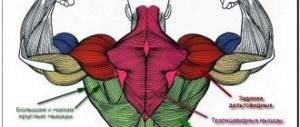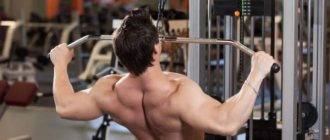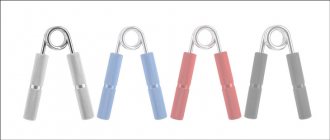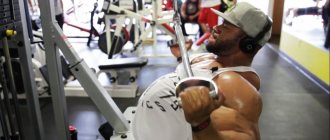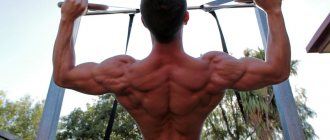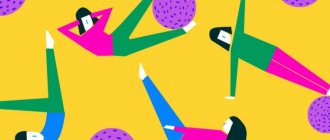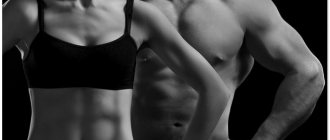August 21, 2021 Admin Home page » Tips and tricks
Learn how to effectively train your abs and back and turn them from weaknesses into strengths.
If the abs and back are your weak points, then the FST-7 workout is what you need, thanks to which these muscle groups will receive maximum load, during which not a single moment will be missed.
The abbreviation FST-7 itself is “fascia - stretching - training”, and the number 7 is the final number of approaches and repetitions in the very last exercise. The main task of this training scheme is micro-tears of a special membrane consisting of connective tissue, which is located around the muscle fibers. These very micro-tears in the connective tissue occur due to their large filling with blood, thanks to super-powerful pumping.
Next, I’ll explain in simpler terms - the main result of FST-7 training will be an increase in the latissimus dorsi muscles and the creation of a truly athletic torso. In addition, the first exercises will be for the abs, this is like preparing the body for hard work on the back. To achieve this goal, we offer you 5 main exercises for the back and 4 using the circular method for the abs.
FST-7 workout for back and abs
Train your abs in a circular manner, that is, perform 1 set of each exercise, then rest for 1 minute and perform 2 sets - 1 minute rest and 3 sets.
— Leg raises lying on an incline bench – 3 sets x 15 repetitions
– Lateral crunches – 3 sets x 15 reps
– Leg raises – 3 sets x 15 repetitions
— Crunches lying on the floor – 3 sets x 15 repetitions
After finishing your abdominal workout, rest for 3-4 minutes and start training your back.
Back training should not be based on the goal of lifting the maximum weight, but to feel the muscles being trained. Rest between approaches should be no more than 1.5 minutes. Each exercise is performed one after another, using the usual training method.
FST
— Pulldowns to the chest – 4 sets x 10 repetitions
— Bent-over dumbbell rows – 2 sets x 10 reps
— Bent-over barbell rows — 2 sets x 10 reps
— Seated rows of the block to the waist – 3 sets x 10 repetitions
7
— Straight arm pull-downs – 7 sets x 7 reps
Choose such a working weight that when performing the planned number of repetitions, the last repetition is the last; if you feel that you can do another 1-2 repetitions, then the weight needs to be increased; if, on the contrary, you do the last repetitions haphazardly, then the weight needs to be reduced, in our case technique is very important and even more so it is reliable protection to reduce the likelihood of injury.
Exercises to develop your upper back
Horizontal block pull
The exercise targets the trapezius, latissimus and rhomboid muscles. To perform it, you need a horizontal block simulator:
- Sit on the platform, pull the cable, grasping the handle with both hands.
- Tighten your abs, straighten your back.
- The stretched handle should be in the abdominal area.
- Bend and straighten your arms at the elbow joint.
- Do 3 slow, steady sets of 12 reps.
On topic: Pump up your biceps with your own hands
Shrugs
To enlarge your trapezius muscles and give them a beautiful shape, do weighted shrugs. Use barbells, a variety of barbells, or dumbbells as additional weight.
- Stand (or sit comfortably) with a weight in your hands.
- The main movement is moving the shoulders up and down.
- Keep your back straight, your gaze should be directed upward.
- Repeat the exercise 15 times in 2 sets.
Arm raises
An excellent exercise for deltas would be doing arm raises in a machine. It helps pump up individual muscle groups in the upper back and shoulder girdle.
- Sit comfortably on the platform (adjust its height if necessary), grab the handles with both hands.
- Raise your arms to the sides, tensing your back muscles.
- Do not fully extend your elbows; keep them tense.
- Perform 2-3 sets of 12-14 repetitions.
Exercise in the simulator
Chest cravings
The exercise is similar to a regular block row, only it is performed while standing and the row itself is carried out from top to bottom. Here the infraspinatus and supraspinatus muscles, teres minor and major, latissimus and rhomboids are worked.
- Stand in front of the machine, feet shoulder-width apart.
- Pull the handle with the cable towards you, causing the weight block to move.
- Elbows should be pressed to the body (but not touching it).
- Bend and straighten your arms, including the muscles of your back and shoulder girdle.
- Number of approaches: 3 x 10–12 repetitions.
Row from a standing position
Tips for correctly performing FST-7
TRAINING THE PRESS USING THE CIRCULAR METHOD - perform all repetitions and approaches slowly, after the approach you should feel the load, that the abs are compressed and tense. Focus on the quality, not the quantity, of reps you do, you can do 20 more reps than everyone else, but what's the point?!, if you don't feel the burning in your stomach.
PULLING THE UPPER BLOCK TO THE CHEST – the main thing is to correctly take the starting position, leaning back a little, bend in the lower back, move your chest forward, look up at the block. When pulling the block down, try to squeeze your shoulder blades together as much as possible, while your elbows fall straight down; when lifting the block, relax your back muscles a little to stretch them well for the next powerful contraction.
With each subsequent approach, increase the weight slightly, and on the very last approach, do an additional 2-3 partial reps, which will allow for maximum tension and break through stagnation for further muscle growth.
DUMBBELL SLOW TO THE BELT - can be performed either with your knee on the bench or with your hand on a comfortable base, only in the first case the back is parallel to the floor, and in the second at an angle of 45 degrees.
The main thing in the exercise is to stretch the latissimus muscles well; to do this, lower the dumbbell down diagonally forward, try to stretch your back muscles as much as possible and with a powerful movement, but without jerking, pull the dumbbell to your belt. During the lifting process, only the arm lever works; the back does not rise and remains as motionless as possible, otherwise part of the load will go to the lower back.
BENT-UP BAR PULL – take a position of approximately 45 degrees to the floor, with your chest turned out, your back straight, your abs tense, with a powerful movement, pull the bar to your lower abdomen, bringing your shoulder blades together as much as possible, lowering the bar, do not round your back, it is straight throughout the entire exercise. The grip needs to be periodically changed to reverse (palms facing forward), in which case the biceps will be actively involved in the work.
If you feel that your forearms cannot stand it and the barbell slips out of your hands, which does not allow you to properly pump your back muscles, use wrist straps, they will remove some of the load from your forearms and emphasize the load on your back.
BLOCK PULL TO THE WAIST SITTING – to perform this exercise, the back muscles are already well engorged with blood, including the lower back, so 3 approaches will be enough to perform the block row without using partial repetitions.
When performing the exercise, make sure that when pulling the block to your belt, it touches the torso, the elbows move as close to the torso as possible, the shoulder blades are brought together, when lowering, relax your back slightly, rounding it slightly to further stretch the lats.
UPPER BLOCK PULL WITH STRAIGHT ARMS is the last exercise for final working out the back; in it, pay utmost attention to the execution technique, when the block is pulled up, while the chest drops down, this is the only way the lats will get a good stretch for subsequent powerful contraction. Don’t forget that the rest between rounds of this exercise is 45 seconds; this will allow you to “hammer” your back muscles as much as possible, bringing them to muscle failure through excellent pumping.
Exercises for a strong back
- "Superman" Lie on your stomach, take dumbbells in your hands. Raise your body and arms a little, look at the floor. Then bend your elbows and pull the dumbbells towards your shoulders, while squeezing your shoulder blades. Do 15 times.
- Raising opposite arms and legs Get on your knees and place your palms on the floor. Raise your left arm and right leg straight. Hold for 30 seconds. Lower the limbs, repeat for the other arm and leg.
- Dumbbell row Sit down, stretch your legs, take dumbbells in both hands. Keep them in front of you. Then pull the dumbbells to your ribs, squeeze your shoulder blades together, do not arch your back. Extend your arms in front of you. Repeat 15 times.
- Expander traction If you don't have a resistance band, perform this exercise with an elastic fitness band or just hold dumbbells in your hands.
Take an expander and stand on the cord with your feet. Lean your body forward, bend your knees. Then bend your elbows, squeeze your shoulder blades together, and pull your handles toward your hips. Straighten your arms. Do 15 times.
After class, do some light stretching. To see the result, perform the complex every other day!
- Share on Facebook
The most effective abdominal exercises
Below is a set of the most effective options, which are also good for their versatility: they can be performed both in the gym and at home, if you have the necessary minimum sports equipment: a horizontal bar and a gymnastic mat. But, if you can still do without a horizontal bar, then it’s better to spend money on a mat, otherwise there is a risk of “chipping” the skin in the tailbone area with a large number of repetitions.
Hanging Leg Raise
Coaches call him “fiery.” For beginners, it is better to consider the option of lifting your legs while resting on your elbows in a special frame, since not everyone can do it correctly in a free hang. Technique:
- The back is pressed against the back of the machine, place your elbows on special supports;
- As you exhale, the bent knees rise at least to the level of the belt and “twist” a little higher by using the abdominal muscles and moving the pelvis forward;
- Hold for a second at the top point and smoothly lower the legs as you inhale, not until they are parallel to the body, but until an obtuse angle is formed. This will reduce the risk of spinal injury.
You can do it hanging on the horizontal bar - it’s more difficult. You need to keep your body straight and not sway, so as not to create inertia of movement.
Advantages:
- Works the entire rectus abdominis muscle;
- Strengthens your back and arms.
Flaws:
- It is quite difficult to perform even in the lightweight version with a stop in a special frame;
- When performing hanging on the horizontal bar, the arms of unprepared beginners quickly get tired.
You can remove the load from your hands using special fasteners. These can be hooks for a horizontal bar or Beres loops. Which of these sports accessories is best to buy depends on individual preferences.
Important! You cannot “swing” your legs, moving them far back at the lowest point and quickly throwing them up - this is a sure way to injure the spine, and these swings will have no effect.
“Book” from a lying position
The authorship of this variation of twisting is attributed to Arnold Schwarzenegger, who four times received the title “Mr. Universe” at bodybuilding and bodybuilding competitions. Technique:
- Lie down on a special rug or mat, stretch your arms and legs in one line;
- As you exhale, simultaneously lift your legs and torso off the floor, trying to reach your forehead to your knees;
- A second pause at the end point, a slow return to the starting position;
Important! Legs and arms should remain straight. Here, too, there is no need for inertial “swinging” of the limbs - all movements must be controlled; you need to pull your forehead to your knees not with your back or legs, but with your abdominal muscles.
Advantages:
- Effective for the rectus abdominis muscles.
Flaws:
- Ineffective and dangerous if performed incorrectly.
In the future, to increase the effectiveness of the exercise, you can use special weights for the arms and legs. You can buy them at a sports store. According to buyers, there is not much difference between branded weights from the best manufacturers of sports equipment and budget analogues. Both are made of dense material that prevents the filler from spilling, have Velcro fasteners and are equally convenient to use. The main difference: in the form and the presence or absence of a corporate logo.
Crunches from a lying position
At first, you can rest your feet on a bench or chair, but keeping your shins in a free hang increases the effectiveness of the workout. Also performed on a mat:
- Lying down, bend your knees, fixing them so that your shins form parallel to the floor;
- As you exhale, the body rises forward, the forehead reaches towards the knees;
- A second pause at the top point, the body lowers smoothly, but does not lie on the floor, stopping a few centimeters away - this increases efficiency.
Important! The back should be rounded, the hands should be at the temples, and hands should not be clasped behind the head.
Advantages:
- Works well on the entire muscle group, forming cubes.
Flaws:
- It is difficult to keep your legs suspended and at the same time control that your body does not touch the floor.
Plank
A static exercise for the abs and buttocks, simultaneously working the muscle groups of the legs and back. Legs and body form a straight line, stand on elbows and toes. This position must be held for at least 30 seconds, gradually increasing it to two minutes.
Important! The back should be straight, you should not bend or hunch. The pelvis should not sag or rise, forming an obtuse angle between the legs and the body.
The picture below shows an incorrect execution of the plank.
Advantages:
- Works almost the entire body.
Flaws:
- It is very difficult to keep a straight line with your legs and body even for 30 seconds.
Oblique crunches
Performed in a lying position on the mat:
- The left leg is bent at the knee, the right arm is at the elbow, the left arm and right leg are extended;
- As you exhale, the left hand reaches out to the right leg, the body twists towards the right leg, and as you exhale, you return to the starting position.
Important! These twists are performed as quickly as possible, and the movements must be strictly controlled. The swing arm and leg should be straight. For 1 approach you need to perform at least 15 repetitions on each arm/leg.
Advantages:
- Works the lateral abdominal muscles well.
Flaws:
- It is quite difficult to perform fast movements without inertia, under control.
All these home exercises are suitable for both boys and girls, they work the entire abs.
Below is a rating of effective crunches performed in the gym using sports equipment with weights.
Twisting with a roller
The minimum number of repetitions is from 15. Option for beginners:
- Get on all fours, holding the handles of the roller, a meter from the wall. The wall here serves as a fixing point, preventing the roller from going further than necessary to avoid back injury;
- As you exhale, roll the roller with straight arms to the wall, straightening your legs at the knees, and as you inhale, return to the starting position.
An option for more experienced athletes: roller rolling from the knees, but without a wall, the length of the roller is controlled by the body.
Option for professionals: rolling with straight legs from a standing position is the most traumatic option, suitable only for those who have good stretching, developed stabilizer muscles (responsible for body balance) and a strengthened spine. This option uses almost all muscle groups: stomach, back, legs, chest, shoulders, arms.
Important! When performing twisting in any of the variants, jerking is unacceptable - only smooth, controlled movement. The arms and back should be straightened, hunched over and bending the elbows - this means that you will get injured in the elbow and shoulder joints or the lumbar spine. For those who are not confident in their abilities, it is better to start rolling against the wall.
Advantages:
- Effectively works the rectus abdominis muscle, indirectly the arms, back and lower back. You can do it at home - just buy a roller at a sports store.
Flaws:
- It is necessary to strictly follow the rules of execution, otherwise injury to the joints and lumbar spine is guaranteed.
The exercise can be included in your home training program if you purchase a video clip from a sports store. Main selection criteria:
- The wheel should rotate freely in both directions, without jamming;
- The handles should be wide enough, not hollow, to support heavy weight and be comfortable to hold.
You can pay attention to inexpensive models made from the same materials and having the same functionality as branded counterparts from the best manufacturers of sports equipment. If the difference is only in design, does it make sense to overpay “for beauty”?
Crossover crunches with weights
It’s good to alternate them with multi-repetition drying workouts. Technique:
- Attach a flexible double-sided triceps rope to the upper mount of the block (available in almost any gym);
- Take the apparatus in both hands and kneel at a distance of 60-70 cm from the simulator - the distance is calculated individually so that when bending over you do not hit your forehead on the blocks or racks of the simulator;
- Pull the projectile down so that your fists with the rope clamped in them are at the level of your temples;
- As you exhale, bend your body so that your forehead stops a few centimeters from the floor, and as you exhale, return to the starting position.
Important! Hands holding the projectile should be bent at the elbows, fists near the temples. The back should be rounded; you should not bend or turn your shoulders to avoid injury to the spine. The body should bend the abdominal muscles, the arms in this case are only weight holders that fix its position, nothing more. It is better to start with small weights, calculating it so that you can do 15-20 repetitions without the risk of releasing too heavy a projectile from your hands, and you should feel tension in the abdominal muscles. As soon as the weight becomes light, it needs to be increased by 5 kg.
Advantages:
- Works a muscle group, forms cubes.
Flaws:
- Not suitable for home training.
Incline crunches
Performed with a rounded back, hands at the temples. The legs are fixed with special bolsters. Technique:
- Starting position: the body is lowered, but does not touch the bench, while exhaling - twisting to the knees, while inhaling - returning to the starting position.
Important! When returning to the starting position, you must not fall with your back on the bench and push off from it in order to twist; the body must be suspended at all times. The minimum number of repetitions is 15.
Advantages:
- By increasing the incline of the bench, you can increase the load and constantly progress.
Flaws:
- It is very difficult to keep your body suspended on an incline bench.
Hyperextension crunches
They work the lateral muscles, strengthening them. The minimum number of repetitions is 20. Execution:
- Starting position: sideways, thigh lying on one of the exercise pads, hands behind your head.
- As you exhale, tilt to the side; as you inhale, return to the starting position.
Important! The back should be straight, shoulders straightened. You should not bend your back at the waist, as this can be traumatic for the lumbar spine.
Advantages:
- Complete workout of all oblique abdominal muscles.
Flaws:
- Injury due to improper execution.
Crunches in a weighted machine
They work the rectus muscle and strengthen the back. Performed sitting or standing (depending on the type of simulator). The minimum number of repetitions starts at 20. Execution:
- The hands are fixed on special handles, the back is slightly bent;
- As you exhale, twist down, and as you inhale, return to the starting position.
Advantages:
- By increasing weight, you can constantly progress, making the cubes on your stomach prominent and visually pronounced.
Flaws:
- Due to the wrong choice of weight, the load will be either insignificant or excessive. The latter can cause discomfort in the muscles several hours after training.
All of the above twisting options are suitable for both men and women. If done correctly, they will work every abdominal muscle.
It is enough to perform two abdominal exercises three times a week, alternating high-repetition variations with weight training.

